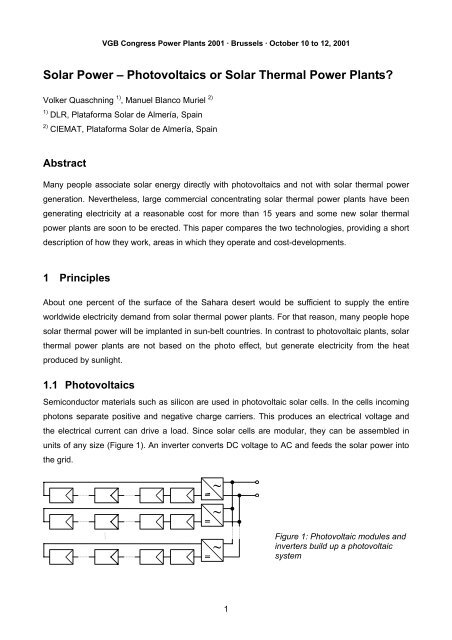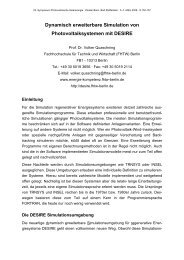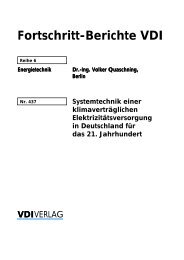Photovoltaics or Solar Thermal Power Plants? - Volker Quaschning
Photovoltaics or Solar Thermal Power Plants? - Volker Quaschning
Photovoltaics or Solar Thermal Power Plants? - Volker Quaschning
You also want an ePaper? Increase the reach of your titles
YUMPU automatically turns print PDFs into web optimized ePapers that Google loves.
VGB Congress <strong>Power</strong> <strong>Plants</strong> 2001 · Brussels · October 10 to 12, 2001<strong>Solar</strong> <strong>Power</strong> – <strong>Photovoltaics</strong> <strong>or</strong> <strong>Solar</strong> <strong>Thermal</strong> <strong>Power</strong> <strong>Plants</strong>?<strong>Volker</strong> <strong>Quaschning</strong> 1) , Manuel Blanco Muriel 2)1) DLR, Plataf<strong>or</strong>ma <strong>Solar</strong> de Almería, Spain2) CIEMAT, Plataf<strong>or</strong>ma <strong>Solar</strong> de Almería, SpainAbstractMany people associate solar energy directly with photovoltaics and not with solar thermal powergeneration. Nevertheless, large commercial concentrating solar thermal power plants have beengenerating electricity at a reasonable cost f<strong>or</strong> m<strong>or</strong>e than 15 years and some new solar thermalpower plants are soon to be erected. This paper compares the two technologies, providing a sh<strong>or</strong>tdescription of how they w<strong>or</strong>k, areas in which they operate and cost-developments.1 PrinciplesAbout one percent of the surface of the Sahara desert would be sufficient to supply the entirew<strong>or</strong>ldwide electricity demand from solar thermal power plants. F<strong>or</strong> that reason, many people hopesolar thermal power will be implanted in sun-belt countries. In contrast to photovoltaic plants, solarthermal power plants are not based on the photo effect, but generate electricity from the heatproduced by sunlight.1.1 <strong>Photovoltaics</strong>Semiconduct<strong>or</strong> materials such as silicon are used in photovoltaic solar cells. In the cells incomingphotons separate positive and negative charge carriers. This produces an electrical voltage andthe electrical current can drive a load. Since solar cells are modular, they can be assembled inunits of any size (Figure 1). An inverter converts DC voltage to AC and feeds the solar power intothe grid.~~~Figure 1: Photovoltaic modules andinverters build up a photovoltaicsystem1
V. <strong>Quaschning</strong> and M. Blanco <strong>Solar</strong> <strong>Power</strong> – Photovoltaic <strong>or</strong> <strong>Solar</strong> <strong>Thermal</strong> <strong>Power</strong> <strong>Plants</strong>?All the collect<strong>or</strong>s track the path of the sun on their longitudinal axes. The mirr<strong>or</strong>s concentrate thesunlight m<strong>or</strong>e than 80 times on a metal abs<strong>or</strong>ber pipe in the line of focus. This pipe is embedded inan evacuated glass tube to reduce heat loss. A selective coating on the abs<strong>or</strong>ber tube surfacelowers emission losses. Either water <strong>or</strong> a special thermal oil, runs through the abs<strong>or</strong>ber tube. Theconcentrated sunlight heats it up to nearly 400 °C, evap<strong>or</strong>ating water into steam that drives aturbine and an electrical generat<strong>or</strong>. After passing through the turbine, the steam condenses backinto water that is returned to the cycle (Figure 3).A fossil burner can drive the water-steam cycle during periods of bad weather <strong>or</strong> at night. Incontrast to photovoltaic systems, solar thermal power plants can guarantee capacity. This optionincreases its attractiveness and the quality of planning distribution over the grid. <strong>Thermal</strong> st<strong>or</strong>agecan complement <strong>or</strong> replace the fossil burner so that the power plant can be run with neutral carbondioxide emissions. In this case, heat from st<strong>or</strong>age drives the cycle when there is no direct sunlight.Biomass <strong>or</strong> hydrogen could also be used in the parallel burner to run the power plant withoutcarbon dioxide emissions.Figure 4:Experimental centralreceiver system atthe Europeanresearch centerPlataf<strong>or</strong>ma <strong>Solar</strong> deAlmería in SpainThe solar field of a central receiver system, <strong>or</strong> power tower, is made up of several hundred <strong>or</strong> evena thousand mirr<strong>or</strong>s, called heliostats, placed around a receiver at the top of a central tower. (Figure4). A computer controls each of these two-axis tracking heliostats with a tracking err<strong>or</strong> of less thana fraction of a degree to ensure that the reflected sunlight focuses directly on the tower receiver,where an abs<strong>or</strong>ber is heated up to temperatures of about 1000 °C by the concentrated sunlight. Air<strong>or</strong> molten salt transp<strong>or</strong>ts the heat and a gas <strong>or</strong> steam turbine drives an electrical generat<strong>or</strong> thattransf<strong>or</strong>ms the heat into electricity.3
V. <strong>Quaschning</strong> and M. Blanco <strong>Solar</strong> <strong>Power</strong> – Photovoltaic <strong>or</strong> <strong>Solar</strong> <strong>Thermal</strong> <strong>Power</strong> <strong>Plants</strong>?2 Reference SystemsBoth photovoltaics and solar thermal power plants have proven their feasibility in many operatingyears at a large number of reference systems. There are relevant megawatt-size referencesystems in both technologies.2.1 <strong>Photovoltaics</strong>Only a few photovoltaic demonstration systems in the megawatt range were built in the lastdecade. At the moment various large systems are planned <strong>or</strong> under construction. Reliable generalconditions given by fed-in laws in Germany and Spain supp<strong>or</strong>t the erection of new large system.The number of new systems will increase continuously within the next year resulting in decreasingcosts.Table 1: Examples of photovoltaic systems in the megawatt rangePlace of large PV plants Country Installed capacity Start of operationToledo Spain 1.0 MW 1994Serre Italy 3.3 MW 1994Munich Germany 1.0 MW 1998Herne Germany 1.0 MW 1999Tudela Spain 1.2 MW 2001 (planned)Relzow Germany 1.5 MW 2001 (planned)Relzow Germany 3.5 MW 2002 (planned)2.2 <strong>Solar</strong> <strong>Thermal</strong> <strong>Power</strong> <strong>Plants</strong>The first commercial parabolic trough power plant was built in the Mojave Desert in Calif<strong>or</strong>nia in theyear 1984. By 1991, nine trough power plants with a total capacity of 354 MW e , which feed about800 million kWh per year into the grid, had been erected on m<strong>or</strong>e than 7 km² (Figure 5). Eight ofthem can also be driven with fossil fuel to produce electricity during bad weather <strong>or</strong> at night. Theannual share of the thermal energy produced from gas is limited by statute to 25 percent. The totalinvestment in all of the systems was m<strong>or</strong>e than 1.2 billion USD. A large number of the plantcomponents were produced in Europe. The levelized cost of solar electricity was reduced from0.27 USD per kWh in the first power plant to about 0.12 to 0.14 USD per kWh in the last installedsystem.Although solar thermal electricity is much m<strong>or</strong>e reasonable than photovoltaic electricity, no m<strong>or</strong>ecommercial power plants have been erected since 1991. However, an increasing number of projectdevelopments make the new construction of parabolic trough systems very probable. The W<strong>or</strong>ldBank has made 200 million USD in financial assistance available f<strong>or</strong> new combined-cycle gas andsolar thermal power plants in developing countries. In Spain, a law increasing compensation f<strong>or</strong>electricity produced from solar thermal energy with a premium of 20 PTA/kWh (about 12 Euro4
V. <strong>Quaschning</strong> and M. Blanco <strong>Solar</strong> <strong>Power</strong> – Photovoltaic <strong>or</strong> <strong>Solar</strong> <strong>Thermal</strong> <strong>Power</strong> <strong>Plants</strong>?cents/kWh) above the market price of 6 to 7 PTA/kWh (about 4 Euro cents/kWh) is expectedsh<strong>or</strong>tly.Figure 5: Aerial view of the solar thermal power plats at Kramer Junction in the US-Calif<strong>or</strong>nianMojave desert (photograph: KJC)3 Areas of OperationThe areas where photovoltaic systems and solar thermal power plants can operate overlap only ina narrow range (Figure 6). Due to their modularity, photovoltaic operation covers a wide range fromless than one Watt to several megawatts and photovoltaic systems are able to operate as standalonesystems as well as grid-connected systems.<strong>Solar</strong> thermal power plants can w<strong>or</strong>k in both areas as well. Dish/Stirling systems are small units inthe kilowatt range. The above-mentioned parabolic trough and solar tower power plants operateonly in the megawatt range.Global solar irradiance consists of direct and diffuse irradiance. When skies are overcast, onlydiffuse irradiance is available. While solar thermal power plants can only use direct irradiance f<strong>or</strong>power generation, photovoltaic systems can convert the diffuse irradiance as well. That means,they can produce some electricity even with cloud-covered skies.5
V. <strong>Quaschning</strong> and M. Blanco <strong>Solar</strong> <strong>Power</strong> – Photovoltaic <strong>or</strong> <strong>Solar</strong> <strong>Thermal</strong> <strong>Power</strong> <strong>Plants</strong>?3000kWh/(m² a)2500global h<strong>or</strong>izontal irradiationdirect n<strong>or</strong>mal irradiation DNI200015001000500030 35 40 45 50 55 60latitude in °Figure 7: Global h<strong>or</strong>izontal irradiation and direct n<strong>or</strong>mal irradiation in various locations in Europeand N<strong>or</strong>th Africa depending on latitudelevelized electricity costs in Euro/kWh0.80.70.60.50.40.30.20.1photovoltaics (today)photovoltaics (50 % cost reduction)solar thermal power plant030 35 40 45 50 55 60latitude in °Figure 8: Present levelized electricity costs f<strong>or</strong> solar thermal power plants and photovoltaicsystems as well as levelized costs f<strong>or</strong> photovoltaic systems with 50 % cost reduction f<strong>or</strong> locationsin Europe and N<strong>or</strong>th Africa depending on the latitude7









